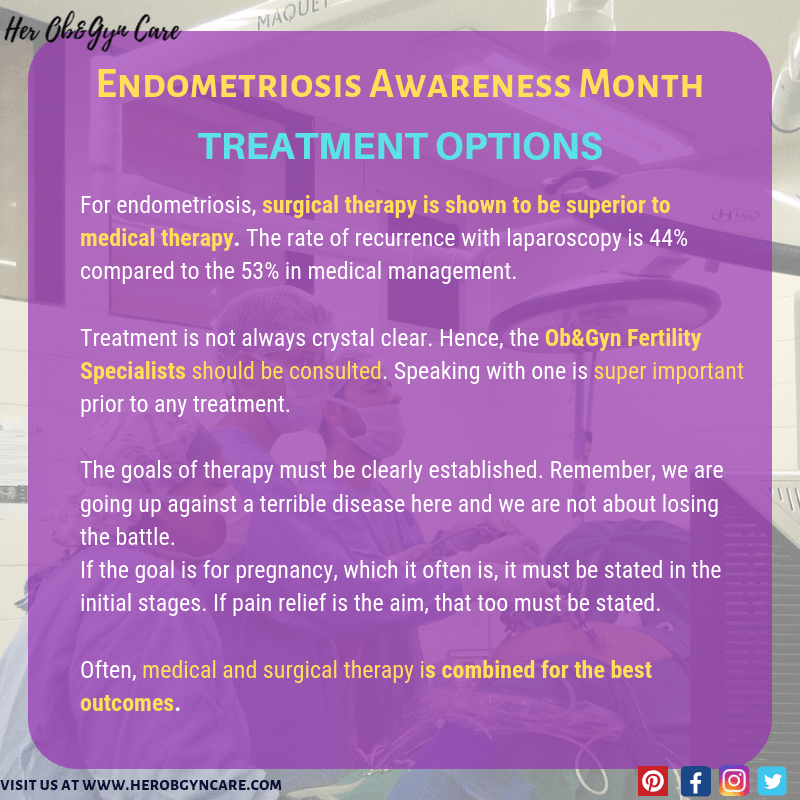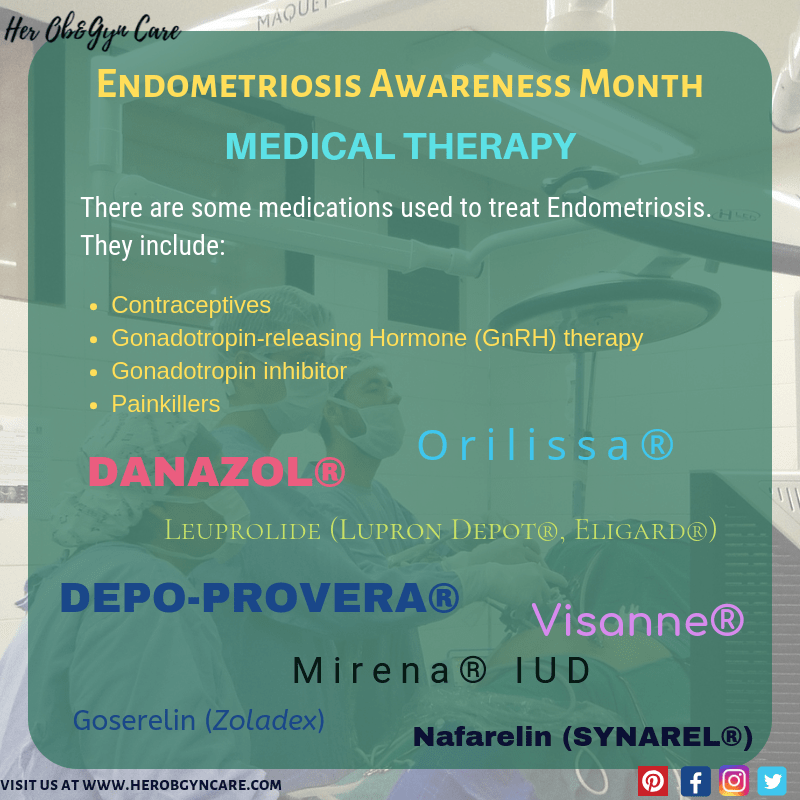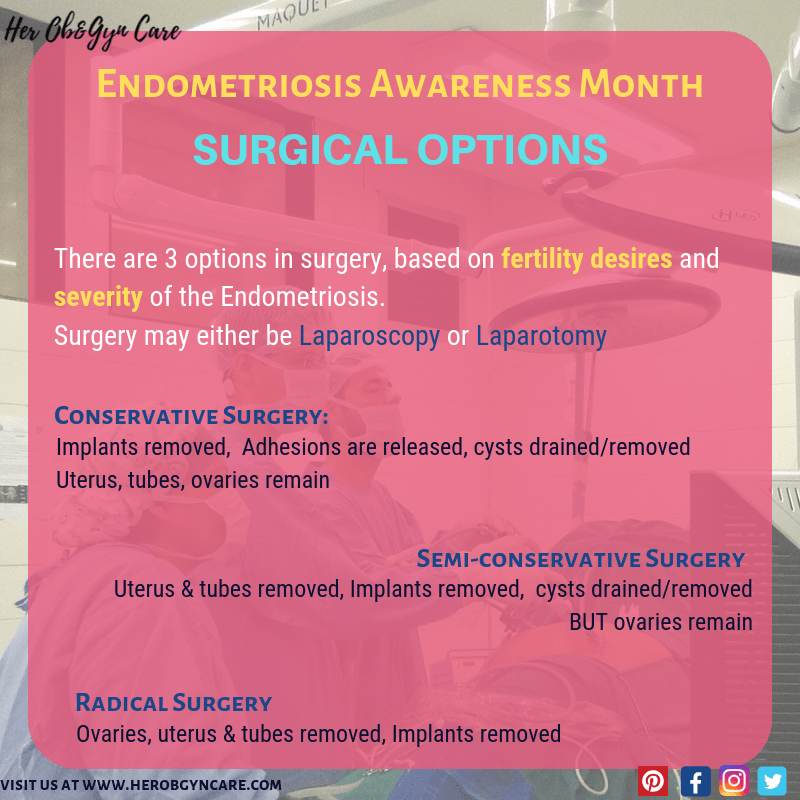Hey Lovies!
Thanks, for joining us another time for a knowledge-packed, learning session on Endometriosis!
Today, you are reading the last post in the series this year.
March is Endometriosis Awareness Month and we really did a piece with it.
In the previous posts, we defined Endometriosis, looked at how common it is, women who are most affected, they way they are affected and how it is diagnosed.
Today, we will talk about how it is treated.
If you didn’t read the previous posts, I urge you to, because then you will see the true reasons why we and your Ob&Gyn specialist stress the need for treatment after diagnosis.
Importance of Treatment in Endometriosis
This is the better part of the entire discussion on Endometriosis Awareness. You need to know what can be done to treat this terrible disease.
With most health conditions, treatment can either be medical or surgical.
Aim in treatment
Improving fertility chances
If your aim is to get pregnant, then you ought to know that the pregnancy must be planned and detailed. That is, the Ob&Gyn specialist will give you dates that you and your partner must fulfil.
The specialist will first determine the cause of subfertility. Then they will decide if you will benefit most from medical or surgical treatment or both. The use of both routes gives better outcomes.
In stage 3 and 4, surgery is superior. However, medical therapy may be employed, especially interval therapy with GnRH agonists to improve pregnancy rates.
If that fails to improve, then assisted conception such as IVF or ICSI may be better options.
Based on review of researches done in the area, clinicians are unclear if surgery before assisted conception is necessary, especially in cases of endometriomas as the outcome of live births is the same compared to women without endometriosis.
Interval therapy
Some physicians may use medications to suppress the menstrual cycle in women who are not symptomatic of their endometriosis with a view to improve pregnancy rates.
However, a Cochrane review in 2015 showed that there are no benefits to suppressing ovulation in these women who are already sub-fertile.
Options for Medical Management
- Contraceptives
- Those prescribed will mainly be with pills and injections based on the drug being used. Sometimes intra-uterine coils may be used.
- Visanne®, a progesterone pill, is the most popular agent specially designed for women with Endometriosis.
- Other options include Depo-Provera® and Megestrol acetate and the Mirena® IUD
- Benefits: Double protection from epithelial ovarian tumours, for which endometriosis is an added risk factor. Then there are the other non-contraceptive health benefits.
- Gonadotropin-releasing Hormone (GnRH) therapy
- These medications modify the reproductive cycle from the brain.
- They work by shutting down the menstrual cycle. They put the body in a menopause-like state.
- Due to its powerful action, such agents can only be used for up to 6 months at a time.
- Danazol
- This agent in a gonadotropin inhibitor. It works by blocking the hormones produced and released from the brain from acting in the ovaries and therefore prevents a period.
- It is not as popular as it used to be due to its side effects, but it may be the only option for some women and can work well in some cases.
- Three to six months of therapy is needed for effects to be noticed.
- Painkillers
- Like my story on dealing with period cramps, the same painkillers are usually prescribed. You can give this post a read to find out more!
Options for Surgical Management
There are some factors the specialist will assess to provide the best surgical option. They will assess the age and fertility desires of the client and how their quality of life will change with the surgery.
Then, they can decide if they need to take a conservative approach verses one that is semi-conservative or radical.
The aim of surgery is to remove the endometriotic implants and fixing any anatomical distortions which occur. This commonly includes breaking down adhesions that have formed; re-opening blocked tubes and so forth.
Conservative Surgery
Therapeutic Laparoscopy is this is the gold-standard for treatment. This conservative method is best for women who wish to become pregnant. The success rates are better compared with medical therapy especially when it comes to improving fertility.
The implants are either cut-out or burned off with diathermy. Adhesions are released too. If there is an endometrioma, this may be drained, or the entire cyst removed.
For chronic pain, the nerves involved may be removed. After surgery, women with stage 1 or 2 disease may need some amount of medical therapy to continue reducing pain.
Semi-Conservative Surgery
In this option, the uterus, tubes and visible deposits are removed, but the ovaries are retained so that menopause is not started.
This is an option for women who have severely debilitating disease or who have completed their families but want to be spared of a surgically induced state of menopause.
The downfall of this method is that there is still a risk of recurrence; up to 6 times more likely compared to women who have their entire ovaries removed.
Radical Surgery
This surgery is called a total abdominal hysterectomy and a bilateral salpingo-oophorectomy (TAH + BSO). It is the removal of the uterus, tubes and the ovaries. This is only done in women who have completed their families with no future fertility desires OR women who have severe debilitating disease which fails to respond to medical therapy or other non-radical approaches.
The implants in the pelvis and abdomen are also removed.
It is reported that some endometriosis may recur even after this extensive surgery, but the likelihood is very very RARE.
Even if they have no children, they may need the TAH if they want to have a better quality of life. In these cases, there is a lot of remorse, but many women find solace in adoption and getting involved in the fight against Endometriosis to help other women across the world.
Wrapping Up
We are at the end of the series ladies! I hope you learned so much more than you knew before.
I hope you were enlightened and empowered to make the best decisions for your health.
Your knowledge is your power.
Remember that sharing is caring, so send this with your lady friends and family members.
Teach them something new today!
You should follow us on social media where we share other info on Endometriosis and other important topics about sex and fertility.
Instagram: Wannabe_futureObgyn
Facebook: Her Ob&Gyn Care
Facebook Group : Lovies Tribe of Her Ob&Gyn Care
Pinterest: Her Ob&Gyn Care*
All the best, lovies!
Have an endometriosis-free week!
XOXO
Creator, Her Ob&Gyn Care©
References
Willy Davila, G., MD, Kapoor, D., MD, MBBS, MRCOG, Alderman, E., MD, Hiraoka, M. K., MD, Ghoniem, G., MD, FACS, Peskin, B., MD, MBA, & Price, T. M., MD. (2018, July 27). Endometriosis (M. Rivlin MD, F. Casey MD, MPH, & F. Talavera PharmD, PhD, Eds.). Retrieved March 6, 2019, from https://emedicine.medscape.com/article/271899-overview.
Triolo, O., Laganà, A. S., & Sturlese, E. (2013). Chronic pelvic pain in endometriosis: an overview. Journal of clinical medicine research, 5(3), 153-63.






